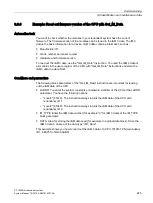
Commissioning
9.5 CPU memory reset
S7-1500R/H redundant system
System Manual, 10/2018, A5E41814787-AA
231
9.5
CPU memory reset
Basics of a memory reset
Memory resets can be performed for the primary and for the backup CPU. Memory resets
are generally only useful for the primary CPU.
Reason: Following a primary CPU memory reset, you need to trigger synchronization for
redundant operation. In SYNCUP, the backup CPU is synchronized with the retentive data
from the primary CPU. Following SYNCUP, the backup CPU processes the same user
program as the primary CPU.
The memory reset process for R/H-CPUs is identical to that for the S7-1500 standard CPUs.
The CPU must be in the STOP operating state for a memory reset.
A memory reset returns the CPU to its "initial state".
Note
A memory reset only ever affects the CPU to which you have applied the function. For a
memory reset of both CPUs, apply the function to each in turn.
Memory reset means:
●
An existing online connection between your programming device/PC and the CPU is
terminated.
●
The content of the work memory and the retentive and non-retentive data are deleted (in
a manual memory reset).
●
The diagnostics buffer, time of day, and IP address are retained.
●
Subsequently the CPU is initialized with the loaded project data (hardware configuration,
code and data blocks, force jobs). The CPU copies this data from the load memory to the
work memory.
●
Data blocks no longer have actual values but rather their configured start values.
●
Force jobs remain active.
Detecting a CPU memory reset
The RUN/STOP LED flashes yellow at 2 Hz. After completion, the CPU switches to STOP.
The RUN/STOP LED is on (constant yellow light).
Содержание Simatic S7-1500H
Страница 1: ......
















































